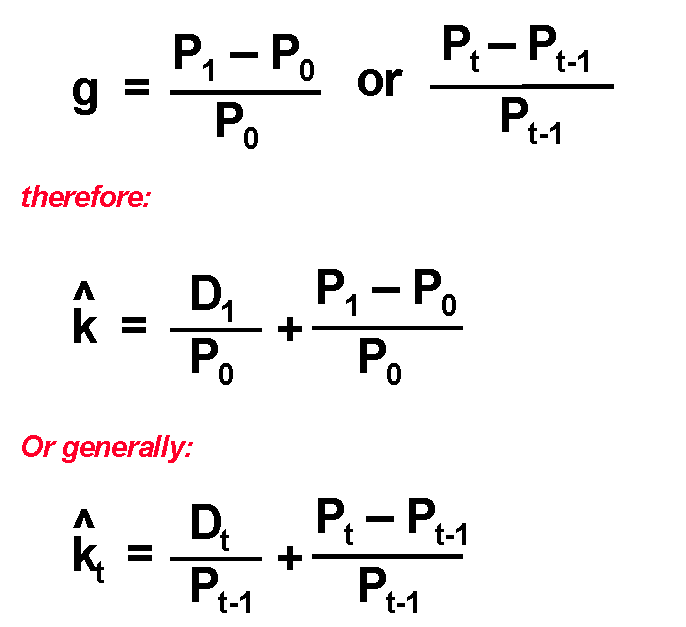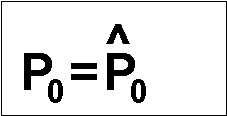
Stock Valuation
Readings: Chapter 8
At the end of this unit students should be able to:
Identify some of the more important rights that come with stock ownership and define the following terms: proxy, proxy fight, takeover, and preemptive right.
Determine the value of a share of preferred stock, or given its value, calculate its expected return.
Determine the value of a share of common stock where: (1) dividends are expected to remain constant (2) dividends are expected to grow at some constant rate, and (3) dividends are expected to grow at some supernormal or non-constant, growth rate.
Calculate the expected rate of return on a constant growth stock.
Calculate the value of a share and a company using the Free Cash Flow (FCF) method.
An
asset which is expected to produce future cash flows has a value which is
equivalent to the present value of all those expected cash flows. An examination of
PV = FV x PVIFk%,n is that the value is a function of:
1.
The amount of the cash flows (FV)
2.
The timing of the cash flows (n)
3.
Investor's required rate of return (k) which is
a function of the riskiness of the expected cash flows
The
Intrinsic value is that value which an investor places on an asset given his
information set (that is all the information that he has) and his expectations
(beliefs). Thus one asset can have different values depending on the investor
valuing it.
The
basic valuation model [also known as the Discounted Cash Flow (DCF) method]
therefore is given by:
|
|
Stock Valuation
.gif)
Where Dt = expected dividend at time t. and k = investor's required rate of return |
Zero growth stock
Since
the value of a stock is dependent on the dividend then the valuation models
should reflect the dividend pattern. Consider a stock which is expected to pay a
constant dividend through time. It will experience no growth or decline in the
future . This is a zero growth stock which is similar to a perpetuity. The price
of the stock is given by:
|
|
Note - a preferred stock is a
type of zero growth stock
Class
Question:
A
local company pays a dividend of $0.15 p.a. and is expected to experience no
growth in the indefinite future. If the investor's required rate of return is 5%
per annum and the stock is being sold for $2.50 in the market place should the
investor purchase the stock?
|
The investor's intrinsic value of the stock would be given by:
Therefore the answer is yes! |
|
i.e. The intrinsic value exceeds the market price |
The
market price reflects the marginal (average) investor's information or
expectations which may be different from that of the individual investor and
therefore the reason for the difference in value.
Normal /Constant Growth Model
This
is also called the Gordon model. It aims to find the expected value of a stock
which is experiencing growth at about the same rate as that of the economy. The
assumption is that if the company maintains its dividend payout ratio then
dividends will grow at about the same rate as the economy.
The
dividend growth model is expressed by
|
|
The
expected or intrinsic value of a stock today given the last period's dividend of
D0, a dividend growth rate
to infinity of g, and the investor's required rate
of return k, is equal to:
|
or more generally:
|
Assumption:
k must be greater than g i.e. k-g (positive) which will give a positive price.
(a negative price is meaningless!)
Class
question
A
Company last paid a dividend of $0.90 . it is expected that dividend will grow
at 25% per annum for the foreseeable future and the investors are requiring 30 %
per annum for stocks in this risk class. What is a fair price for the stock?
|
|
Let's
solve the normal growth equation for k
We
have:
|
|
Note - the k in our normal growth equation is the required rate of return, but when we transform the equation to make k the subject (as we did above), we are finding an expected rate of return. Obviously the transformation requires that k = k^ . This equality holds if the stock market is in equilibrium, a condition that is discussed later below.
Additionally,
remember
that there are two components of the rate of return (Dividend yield +
capital gains yield) i.e. the growth rate is also referred to as the capital
gains yield. This is so because:
 |
A
Company last paid a dividend of $1.35 . It is expected to grow at 25%
indefinitely and has a fair price of $11.25. What is the expected rate of return on the
stock?
|
|
Super normal /Non Constant growth
Some
stocks will experience growth at a higher rate than that being experienced by
the general economy. This may be due to several reasons
1.
The company may be new
2.
The company may just have found an innovative
way of doing things
3.
The company may have captured prime management
These
factors would have provided the company with a competitive advantage over its
rivals. The higher rate of growth as a result of the above will only last for a
limited period after which the company will settle down to more stable growth.
To find the value of such a stock we need a three step approach. In step 1 we discount the individual dividends during the supernormal/non constant growth period and sum the results. In step 2 we find the price of the stock at the end of the supernormal/non constant growth period (a.k.a. Terminal/Horizon date) using only those cash flows expected in the normal growth period and then discount this price back to time zero (0). Finally, in step 3, we add the results from steps 1 & 2.
Example
What
is the price of a stock which last paid a dividend of $2 and is expected to grow
at 25% over the next four years after which it will settle down at a stable rate
of 10% per
 |
 |
 |
 |
Valuation of a Company
The above approach to find the value of a stock that experienced non-constant growth can also be adapted to find the value of a firm, particularly when the firm does not pay regular dividends, if any at all. Valuing the firm will utilize the Free Cash Flow (FCF) concept covered in chapter/topic 2. Recall that:
Free Cash Flow (FCF) = NOPAT – Net investment in operating capital
or FCF = Operating cash flow – Gross investment in operating capital
where:
NOPAT = EBIT (1-T)
Net investment in operating capital = the difference in Total Operating Capital between two years
Total Operating Capital = Net operating working capital (NOWC) + Net Fixed Assets
NOWC = Current assets – non-interest bearing current liabilities
and
Operating Cash Flow = NOPAT + Depreciation
Gross investment in operating capital = Net investment in operating capital + Depreciation
The value of firm using this FCF model is the present value of all of the firm's free cash flows discounted at what is called the weighted average cost of capital (WACC). This WACC will be covered in more detail in Chapter/Topic 9 - Cost of Capital. However for now, the WACC serves the same purpose as that of the 'interest rate' that we have been using up until this point in time i.e. it serves as the rate used to discount cash flows.
Eg. A company who has 100,000 shares of common stock outstanding was recently formed and unlikely to pay any dividends in the foreseeable future. However, its projected free cash flows (all occurring at year end) is as follows:
| Yr | 0 | 1 | 2 | 3 | 4 |
| $ | 0 | 200,000 | 250,000 | 280,000 | 310,000 |
After the fourth year, it is projected that its FCF will grow at a rate of 10% p.a. for the indefinite future. Given that its weighted average cost of capital is 15%, compute (a) the value of the firm as a whole and (b) the value per share.
Solution
(a)
PV = 200,000(PVIF 15%, 1) + 250,000(PVIF 15%, 2) + 280,000(PVIF 15%, 3) + 310,000(PVIF 15%, 4) + [310,000(1.10)/(0.15 - 0.10)](PVIF 15%, 4)
= 200,000(0.8696) + 250,000(0.7561) + 280,000 (0.6575) + 310,000 (0.5718) + 6,820,000(0.5718)
= 173,920 + 189,025+ 184,100 + 177,258 + 3,899,676
= $4,623,979
(b)
= 4,623,979/100,000
= $46.24
|
Useful terms Proxy - a document giving one person the authority to act for another, typically the power to vote shares of common stock. Proxy fight - an attempt by a person or group to gain control of a firm by getting its stockholders to grant that person or group the authority to vote their shares to replace the current management. Takeover - an action whereby a person or group succeeds in ousting a firm's management and taking control of the company. Preemptive right - a provision in the corporate charter or bylaws (Articles of Association) that gives common stockholders the right to purchase on a pro rata basis new issues of common stock (or convertible securities) - similar to a 'rights' issue. |
Stock Market Equilibrium
Recall that kx, the required rate of return on Stock X, can be found using the Security Market Line (SML) equation as was discussed in the Capital Asset Pricing Model (CAPM) in Topic # 4, Risk and Return. i.e. kx = krf + (km - krf) bx . Now, we have just earlier developed a formula to determine a stock's expected rate of return based on the variables: Price, dividends and the growth rate. i.e. k^x = D1 / P0 + g. We have also seen from Chapter 5, Risk and Return, that when the expected rate of return of a stock > the required rate of return the stock, the stock is said to be under priced and when the expected rate of return is < the required rate of return of the stock, the stock is said to be over priced. In the former case, investors will want to buy more of this stock and this great demand will in turn drive the price upwards to the 'correct' price. In the latter case, investors will want to sell their stock, but not many people would want to buy these overpriced stocks. This lack of demand will in turn drive the selling price down towards the 'correct' price.
At this 'correct' price, we will see that the required rate of return = the expected rate of return. i.e.
 |
It is at the above point that the market is said to be in equilibrium. Alternatively, the market is in equilibrium when the actual market price = the intrinsic value i.e.
 |